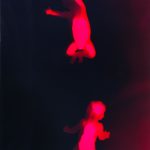
inkjet print, 2017

37.7×56cm, inkjet print, 2017

37.7×56cm, inkjet print, 2017

36.4×56cm, inkjet print, 2017
Dates|November 25 – December 24, 2017
Venue|MEM map
Open Hours|12:00 – 20:00 Closed on Mondays [Tue. if the Mon. is a public holiday]
Tel|+81 (0)3-6459-3205
[Talk Event]
Date&Hour|November 25, 19:00〜
Venue|MEM
Guest|Gen Umezu (The Museum of Modern Art, Saitama)
Admission Free
*Opening reception will be held after the talk.
Photography depends on “light to bind” an image in a single instance.
The photographer as agent produces work with a clearly defined concept. However, there are times when I am in the pursuit of an image, standing beside the strange pool of developing fluid and the image can only be described as having “appeared” despite it being something I made myself. (I call this “the fluctuating edge.”)
For example, I carefully remove the camera installed on a roof for six months, clear away the debris and recover the film. When developing, I carefully scan the one that shows a faint trace of light rays from the sun and adjust with Photoshop. Then unseen traces of light jump out and float to the surface. The revolution of the Earth have remained unchanged for 4.6 billion years. In my photograph the rotation of the cosmos, from winter solstice to summer solstice, are etched with a myriad of lines.
The main focus and subject cannot be summarized as having an active “doing or do” relationship. But perhaps there is another way describe images, different from being either “taken” (active) or “being taken” (passive), but as having “appeared” as an act or condition of the pool of development? Koichiro Kokubun’s The World of The Middle Voice writes about the world before the history of language becomes the confrontationally opposed verbs of “active and passive.”)
Finding a way (or approach) to unlock the pool will give a sense of great satisfaction (despite being slightly intimidating.)
And as a result, I want to take that moment home and place the world seen from that point on “the fluctuating edge” into the medium of photography.
Ken Kitano, September 2017









 Ken Kitano|Others From the Future / Quiet Hand
Ken Kitano|Others From the Future / Quiet Hand  On Mono, Koto and Body – Six Perspectives
On Mono, Koto and Body – Six Perspectives